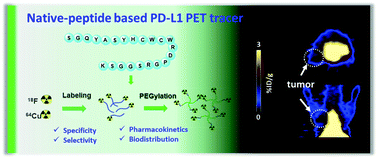Developing native peptide-based radiotracers for PD-L1 PET imaging and improving imaging contrast by pegylation†
Abstract
Herein, a PD-L1 targeted native peptide was developed for PET imaging. 18F and 64Cu were utilized to label the peptide. To improve the pharmacokinetics and biodistribution of the tracers, the peptide was further pegylated to form star-like tetramers. Consequently, four tracers were synthesized with acceptable radiochemical characteristics and their in vivo pharmacokinetics and PD-L1 imaging capability were systematically evaluated. This proof-of-principle study may provide new possibilities for PD-L1 PET imaging in cancers.



 Please wait while we load your content...
Please wait while we load your content...